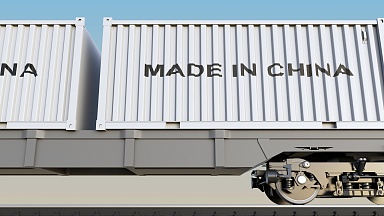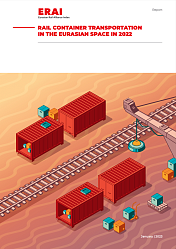1. This year is declared the Year of Railways in the EU. How will this affect Trans-Eurasian transit? What are the key advantages of rail transport in this regard?
The EU’s declaration of 2021 as the Year of Railways is not accidental. It is a trend that has developed in practice.
Of all the modes of transportation, rail proved to be the most resilient to the economic consequences caused by quarantine measures due to the pandemic. The shutdown of production, closure of air services, disruption of schedules, and high freight rates in maritime transport have led to global changes in the supply chain of goods. The redistribution of cargo flows by type of transport was in favor of rail transport.
Its key advantages are obvious, i.e. competitive delivery times and tariffs, and environmental friendliness. Therefore, according to expert data, the railway sector accounts for the smallest share of losses due to the pandemic in the transport sector. And according to the same estimates, rail transport has every chance of a faster recovery compared to others.
And, of course, given this, as well as the EU’s Green Deal, most railway companies welcomed the European Commission’s proposal to declare 2021 the Year of Railways in Europe.
Key issues for discussion and decision-making at the level of international organizations will be issues related to the development of the European railway network on such topics as noise reduction in railway transport, social issues of the railway community, promotion of railway transport in the international tourism market, latest innovations and their implementation, safety in railway transport, cross-border transport, and the environment.
The environmental benefits of rail transport will be achieved through the use of electrification of networks and switching to electric traction, which will eliminate emissions of harmful substances into the atmosphere and reduce soil pollution with heavy metals.
Addressing these issues will certainly contribute to improving the competitiveness of rail transport and further increasing the volume of containerized cargo transported on Trans-Eurasian routes.
2. At the dawn of the development of Trans-Eurasian railway cargo transportation, the optimal scenario was considered to be the transfer of about 3-4% of cargo in transit in the China-Europe-China direction to the railway. Today, according to a number of estimates, this indicator has already reached the level of 6-8%, and the goal for the future is 10% of the market. Are these estimates realistic?
Practice shows that they are realistic.
Important for attracting new customers is the price component for transit, modern, and convenient technological solutions, adaptation to market changes, the development of door-to-door transportation, and the development of points of sale and points of consolidation of goods both in Europe and China.
The technology of organizing regular container trains on routes through Kazakhstan, Russia, and Belarus made it possible to switch the products of the world’s leading automotive industry concerns to rail transport. Currently, Mercedes-Benz, Audi, Porsche, and Range Rover cars are transported by rail from Europe to China on the route through Kazakhstan, Russia, and Belarus, as well as Volvo, whose cars are transported in the China-Europe-China direction.
But the main issue on the agenda today is not to pull over, but to cope with, i.e. to be able to transport the increased volume of cargo. And for this, of course, it is necessary to overcome the existing infrastructure restrictions, especially through the border crossings of Makhalino, Grodekovo, Zabaikalsk, and Far Eastern ports.
As it stands, the railway infrastructure may reach its peak load in the near future. And if we do not take decisive measures to increase the capacity, we will not be able to cope with the increase in transit cargo traffic. We are already facing this problem today.
The long-term development program of Russian Railways provides for an increase in the carrying capacity of the BAM and Trans-Siberian Railway to 180 million tons by 2024 and to 210 million tons by 2025. The BAM modernization program plans to switch raw materials and release significant reserves to promote accelerated regular container services along the Trans-Siberian Railway and stimulate transit.
The modernization of the infrastructure will not only solve the problem of «bottlenecks» on specific sections of transit routes, but will also facilitate the transfer of significant volumes of cargo to the China-Europe-China route in direct rail and multimodal communications.
It is also worth noting that the achievement of a 10% market share of the China-Europe-China rail transit transport provides for close and coordinated interaction of all participants in the transport process. Joint work should be aimed at the seamless passage of border areas and the creation of infrastructure reserves for transit container trains.
3. Digitalization permeates all spheres of life, and railways are no exception. How can railways benefit most from digitalization, especially in the 1520 mm space?
Digitalization is the key to the smooth functioning of railway transport. The introduction of digital technologies and the transition to electronic document management is not just a trend, not just one of the tasks of increasing the competitiveness of international transport corridors, it is a key factor in ensuring the attractiveness of railway and multimodal services in the era of the fourth industrial economy.
Today, the process of transition to digital technologies in the field of transport and logistics has received a new impetus from the introduction of electronic transit customs declarations and transport invoices to the implementation of global promising IT projects. The electronic data exchange developed between the railways on the basis of an electronic digital signature and a trusted third party is the basis for the formation of new competitive digital products and services in the transit transport market.
Here are some examples of how digital technologies make railway services customer-oriented and commercially attractive.
First example. As part of the ICCTT Electronic Train Project, Russian Railways has developed an automated system for creating a through schedule for international container trains based on existing solid train paths.
The introduction and integration of such a system will, from our point of view, increase the attractiveness of rail transportation of block trains in the eyes of cargo owners by:
— elimination of time stochastic behavior and ensuring the determinism of transportation in time;
— possibility of sending a train from any station of the polygon of one railway administration at any planned time to the address of any station of another railway administration with arrival at a specified time.
The very fact that such a system exists will enable representatives of the railway community and freight forwarding organizations to use a new and very serious argument when working with clients to attract the transportation of their goods by rail.
Guaranteed delivery of goods «just in time» will allow carriers and shippers not only to attract additional volumes of cargo, but also:
— avoid penalties paid for exceeding the standard delivery times of goods;
— increase the level of customer-oriented railway services;
— increase the efficiency of work on the sale of train paths to interested entities, thus taking into account their needs;
— adapt the timetable of block trains to the operating modes of the infrastructure during the grace periods;
— improve the efficiency of the use of locomotives and locomotive crews by planning the passage of block trains in advance;
— ensure the possibility of early planning of unloading activities with the subsequent rational use of rolling stock.
Second example. An important step towards the development of cooperation in the digital format and the creation of a single information space for transportation on the China-Europe route is the practical study of technical and technological issues for tracking cargo along the entire route using the «blockchain» technology.
Russian Railways has a positive practical experience in implementing the project «Distributed Data Register in Cargo Transportation» on the «blockchain» platform in transportation involving the ports of the North-West and large customers.
The use of this technology is both a tool for ensuring the transparency and objectivity of transportation data, and digital tracking along the entire route, which is in demand by customers and is a serious competitive advantage for rail transportation. All participants are spared from the need to conclude tons of contracts, and all the rules are recorded in an electronic «smart contract», including mutual settlements and automatic debiting of funds in case of violation of the contract terms, which eliminates the need to conduct claims work.
Third example. One of the measures to simplify trade procedures and the basis for paperless trade is the introduction of the «Single Window» mechanism. The implementation of such a mechanism in practice will reduce the complexity of moving goods across borders and reduce the time of administrative procedures and the costs of participants in foreign economic activity.
As part of the implementation of the «Single Window» mechanism in the Russian Federation, Russian Railways has created an automated information system for electronic interaction (FCS AS EI) for the exchange of electronic data and documents with the automated information system of the FCS of Russia (EAIS) when exporting and importing goods to the customs territory of the Customs Union.
The technologies currently being implemented by the FCS of Russia make it possible to ensure a full-fledged paperless document flow during customs operations, effective interdepartmental information interaction, automation of the process of analyzing commodity deliveries, and making respective decisions.
And one more example. It is impossible not to mention the Electronic Trading Platform Project «Cargo Transportation» of Russian Railways.
With the help of a digital solution, the customer is given an opportunity to order a railway transportation service, as well as related transport services in the scope of those services that are rendered by the affiliated providers of such services.
The client receives a service for ordering railway transportation services both without the provision of cars and with the provision of cars, as well as related services in the form of cargo security, terminal and warehouse services, and other services. Currently, the entire range of services rendered on the Cargo Transportation platform is delivered to both resident and non-resident companies.
In 2020, this service turned into a real marketplace for railway transportation services. This was made possible by the ability to choose the supplier of the ordered service. Previously, the customer ordering the service had to choose it only based on its cost and saw the service provider only after paying for the order. Now the customer sees the supplier and can choose a specific transport brand. This opens up new prospects for the development of the service, since suppliers also have the opportunity to see the customer in the application at the pre-order stage and provide them with a more favorable offer, thus taking into account the loyalty program.
In conclusion, by answering this question, I want to note that today, an important effect of the introduction of digital technologies is also to ensure a contactless process of cargo transportation clearance against the background of quarantine measures due to the pandemic in addition to a significant reduction in the time of cargo clearance. Due to the digital transformation of the business, the efficiency of working in a remote format is significantly increased.
4. What other trends are observed in the cargo transportation market, and which of them do you consider the most significant?
Modern market trends set the task of strengthening the role of the sales system, its greater adaptation to the types of services, the needs of consumers, and the level of their awareness of the company’s capabilities.
An important factor is the presence of a significant number of consumers of the company’s services with differentiated needs, the satisfaction of which requires not only their understanding, but also the prompt acquisition of the necessary sets of services at the right time.
Despite the crisis triggered by the COVID-19 pandemic, the main trend is the growth of containerization of cargo transportation.
Thus, at the end of 2020, 5.8 million TEU were transported through the Russian Railways network (+16.5% compared to last year), of which transit was increased by 37.6% and amounted to 831 thousand TEU (in 2019, 581.32 thousand TEU were transported on the Russian Railways network).
The main share of transit traffic is accounted for by the China-Europe-China connection (561 thousand TEU).
This has also become possible due to the expansion of the geography of container services and the range of goods transported in containers in the China-Europe-China route. The results of 2020 showed an increase in the transportation of machinery and equipment (62.6 thousand TEU), and chemicals using specialized types of containers (35.5 tons TEU).
Transit traffic of agricultural products has increased significantly. For the first time, sugar and cotton were transported in transit. Due to the spread of the coronavirus in the directions of both the East and the West, the transportation of medical goods and equipment is increasing. The demand for transit rail transportation of textiles, perfumes, and cosmetics is growing in the category of consumer goods in the direction of Europe. Transportation of wood and food products is in demand in the direction of China.
The positive effect for the transportation of food is due to the fact that since the spring of 2020, Russia has allowed the transit of sanctioned goods, primarily vegetables, fruits, and high-quality food. Transportation can be carried out through Zabaikalsk, through Ozinki, Orsk, Iletsk-1, and Kartaly on the border with Kazakhstan, and through Smolensk-Sortirovochny with Belarus. In this regard, Russian Railways Logistics JSC together with UTLC ERA launched a project for the transportation of sanctioned goods using electronic navigation seals in March last year. Cargo shipments from Europe to China are carried out within the framework of the project. Main destinations: Germany, Poland, Latvia, and other EU countries — China (Xian, Harbin, Chongqing). The main product lines sent by this service are milk powder and dairy products, frozen meat, and fish/seafood.
With the growth of e-commerce and the closure of air services last spring, it became possible to launch mail container trains to transport international mail by rail from China to Europe. These shipments have shown their effectiveness due to the regularity of the container service and the short transit time. The ICCTT together with UTLC ERA and the Universal Postal Union are actively working to address issues related to the further development of these services.
5. The Eurasian Rail Alliance Index portal serves as an indicator of the state of railway container transit traffic in Eurasia. What opportunities does Index 1520 offer for decision-making? How timely and effective is the portal tool?
The ERAI index shows shippers the current cost of container rail transit services and allows them to compare it with the similar Drewry World Container Index (WCI) sea container transportation indicators in the East-West direction. The ERAI index takes into account such factors as the tariffs of Russian Railways, JSC NC KTZ and Belarusian Railway for transit, the cost of rolling stock, the cost of terminal services, speed and travel time, and the congestion of the railway infrastructure.
The tool allows market participants to determine the cost of the rail container transportation contract, use the indicator when concluding forward contracts, or build an analytical forecast for various methods of cargo delivery.
A comparison of the ERAI and the WCI indices showed that the cost of rail transport is less volatile compared to sea transport. The index allowed to identify the best conditions in terms of cost optimization when choosing railways for transit transport in the long term. While maintaining the current dynamics of development and reducing the total time for delivery, rail transport will increase its competitive advantage, and the index will allow to predict the feasibility of choosing a specific route and mode of transport, thus taking into account the current dynamics.
The ERAI portal has established itself as an authoritative analytical platform that allows to refer to its publications as part of the marketing promotion of transport products sold on Trans-Eurasian routes.
I believe that the Eurasian Rail Alliance Index portal, on the one hand, allows large businesses to react faster and more flexibly to market changes, and thus have more resources to control the situation, and on the other hand, it helps to establish a dialogue and strengthen trust between shippers and transport companies. This is a very important mission fully supported by ICCTT!





